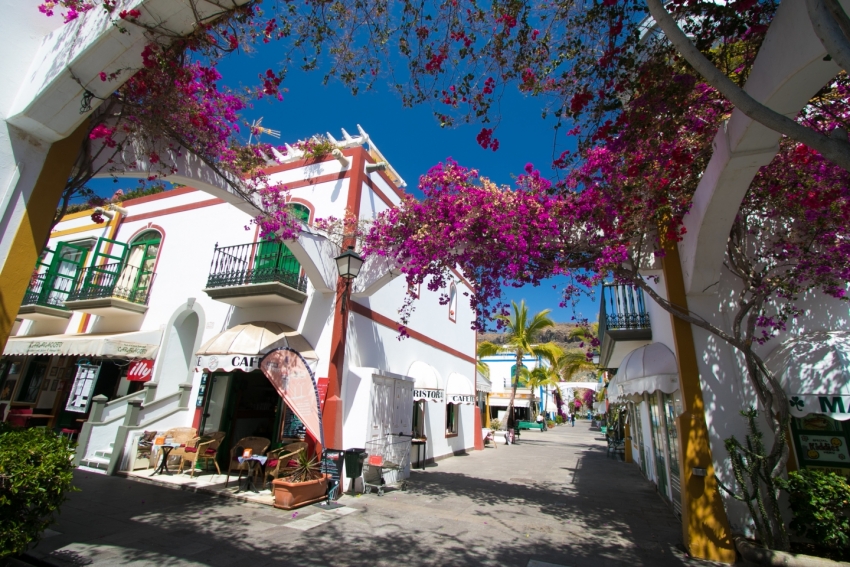Roque Nublo
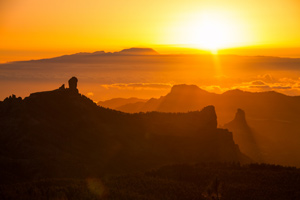 A vast ochre lava plug right at the centre of Gran Canaria, although not at the island's high point; Roque Nublo (Cloud Rock) is within the Parque Rural del Nublo and the Gran Canaria Biosphere Reserve and is surrounded by kilometres of pristine pine forests dotted with pretty rural villages.
A vast ochre lava plug right at the centre of Gran Canaria, although not at the island's high point; Roque Nublo (Cloud Rock) is within the Parque Rural del Nublo and the Gran Canaria Biosphere Reserve and is surrounded by kilometres of pristine pine forests dotted with pretty rural villages.
Conveniently, Roque Nublo is just 25 minutes walk from the La Goleta car park on the GR 600 road so anyone who is reasonably fit can get up close and personal with Gran Canaria's iconic rock. Just remember to take a layer as the temperature changes fast at the top of Gran Canaria.
You can see Roque Nublo from most areas in the centre of Gran Canaria and it looks at its best at dawn and dusk when the rich light makes it glow. One of the best viewpoints is from Pico (Pozo) de las Nieves: The highest point on the island. Here you see Roque Nublo with it's little brother Roque Bentaiga slightly further to the west and Teide volcano and Tenerife on the horizon.
Maspalomas Dunes
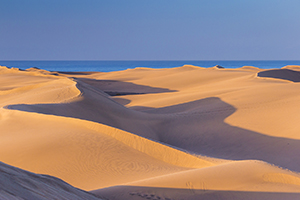 The Maspalomas dunes may look like a bit of the Sahara that blew over to Gran Canaria, but they are a completely natural island feature. Nobody knows how the formed although some experts say a huge tsunami over 200 years ago created the whole dunes, lagoon and beach system in one cataclysmic event.
The Maspalomas dunes may look like a bit of the Sahara that blew over to Gran Canaria, but they are a completely natural island feature. Nobody knows how the formed although some experts say a huge tsunami over 200 years ago created the whole dunes, lagoon and beach system in one cataclysmic event.
Geology aside, the dunes are a patch of wilderness right at the heart of one of the world's biggest tourist resorts. They make what could be an urban area into a wide open space and they provide some of the best photo opportunities in Gran Canaria.
To really appreciate the dunes, get up for dawn and walk into them from the Dunas mirador at the end of Avenida Tirajana in Playa del Inglés. You'll have them to yourself and experience the glow of sunrise and the gradual warming of the sand in complete silence. Then head into the resort for breakfast or across the dunes to the vast Maspalomas and Playa del Inglés beach. Clothes are optional.
If dawn sounds like too much effort, then sunset is just as pretty although you'll have to share the views with lots of other people.
Puerto de Mogán
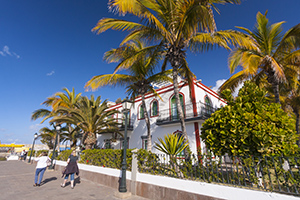 This purpose-built tourist development next to an old fishing village has transcended its resort status and become one of Gran Canaria's top attractions.
This purpose-built tourist development next to an old fishing village has transcended its resort status and become one of Gran Canaria's top attractions.
With pretty white houses, arches of bougainvillea flowers, a lovely golden-sand beach and plenty of places to eat by the water, Puerto de Mogán is a must see spot for Gran Canaria newbies.
Along with the harbour, it's worth walking up the steep paths through the original village for an overview of the marina that everyone now calls 'the Venice of Gran Canaria'.
For more on Puerto de Mogán, see our resort guide.
Seafood by the seaside
 There're plenty of places to eat seafood by the sea in Gran Canaria's main resorts. Puerto de Mogán marina is a great spot, as is the beachfront in Puerto Rico and the upmarket Meloneras boulevard just west of the Maspalomas lighthouse.
There're plenty of places to eat seafood by the sea in Gran Canaria's main resorts. Puerto de Mogán marina is a great spot, as is the beachfront in Puerto Rico and the upmarket Meloneras boulevard just west of the Maspalomas lighthouse.
However, to really experience the coastal atmosphere of Gran Canaria, it's best to head to a local seaside town or village. You don't have to go far from the resorts to find one. Arguineguín town has great beachfront restaurants and little El Pajar village and sandy beach, just east of Arguineguín, is a great local spot that is also just minutes from Maspalomas.
Further afield, all the towns on Gran Canaria's east coast have good seafood restaurants. Melenara beach is a local favourite, while Ojos de Garza, just north of the airport, is as ramshackle and local as they come. In the north, Las Canteras beach in the capital city of Las Palmas has dozens of beachfront restaurants, and the restaurant at the tip of El Roque village in the Moya municipality is as spectacular as they come.
Tucked away in the north-west corner, Sardina de Galdar sits at the base of high cliffs and is a favourite amongst divers and locals. Just south is Puerto de las Nieves; Gran Canaria's white seaside village with a tiny fishermen's harbour and fish as fresh as it comes.
Eat lunch in a highland village
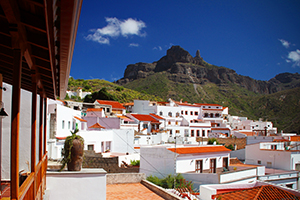 From surf to turf and another must; Lunch in a local restaurant in Gran Canaria's highlands. Head to the white town of Tejeda, or the cave village of Artenara, Gran Canaria's highest, for a taste of the other Gran Canaria where goat and rabbit dominate the menus. Choose a local restaurant with a Spanish-only menu and you won't be disappointed. Country food in Gran Canaria is rich and hearty and perfect after a long drive around the island's rural roads.
From surf to turf and another must; Lunch in a local restaurant in Gran Canaria's highlands. Head to the white town of Tejeda, or the cave village of Artenara, Gran Canaria's highest, for a taste of the other Gran Canaria where goat and rabbit dominate the menus. Choose a local restaurant with a Spanish-only menu and you won't be disappointed. Country food in Gran Canaria is rich and hearty and perfect after a long drive around the island's rural roads.
Dishes to look out for include ropa vieja, a rich stew made from chickpeas and pork flavoured with laurel leaves, and carne de cabra; stewed goat meat.
From the resorts, the easiest way to reach the highlands is to drive up one of the three vast valleys that cut into the island's southern flanks; Mogán, Fataga or Agruineguín. Each one takes you from the coast up through the ochre rocks of the southern flanks and into the pine forest that covers Gran Canaria's highlands.
Shop, see, eat and snorkel the capital
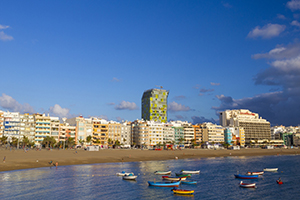 If there's one place in Gran Canaria that takes first-time visitors by surprise, it's the capital city Las Palmas. While most of it is residential, the old town of Vegueta, largely unchanged since Columbus visited in 1492, and the beachfront area by Las Canteras beach are essential spots.
If there's one place in Gran Canaria that takes first-time visitors by surprise, it's the capital city Las Palmas. While most of it is residential, the old town of Vegueta, largely unchanged since Columbus visited in 1492, and the beachfront area by Las Canteras beach are essential spots.
Vegueta is all cobbled streets, traditional wooden balconies and outdoor cafes and restaurants. Visit the Museo Canario for a brief but fascinating introduction to the original Canarians, including a great collection of mummies and pottery. Or climb the cathedral stairs (or take the lift) for a panoramic view of the city.
To experience the inside of Gran Canaria's cathedral, which took almost 500 years to build, head to the south wall of the cathedral and visit the Museo Diocesano De Arte Sacro. Along with a collection of renaissance art and works by some of Gran Canaria's most famous artists, it is set in a stunning Canarian-style building with a beautiful courtyard and it lets you enter the cathedral itself. Highlights here include the vast altar and the elegant stonework on the ceiling that makes the cathedral's pillars look like palm trees.
Over the road is Triana, recently voted the best outdoor shopping area in Spain and riddled with restaurants, flagship fashion stores and independent boutiques. While Vegueta's architecture is medieval gothic and renaissance, Triana is neoclassical and modernist with elegant facades and wrought iron balconies.
 As for Las Canteras beach, let's just say that it is one of the world's great urban beaches with three kilometres of golden sand and everything from surf waves to coconut palm trees. It's so big and varied that you'll need help picking a spot.
As for Las Canteras beach, let's just say that it is one of the world's great urban beaches with three kilometres of golden sand and everything from surf waves to coconut palm trees. It's so big and varied that you'll need help picking a spot.
The snorkeling just off Playa Chica right in the centre of the beach is spectacular with schools of multicoloured parrotfish, striped bream, damselfish and wrasse. If you're lucky, you'll spot octopus, amberjack, oceanic mullet and maybe even a barracuda or grouper.
Las Canteras may be the Las Palmas's biggest beach, but you have four more to choose from within the city.
Go west, life is peaceful there
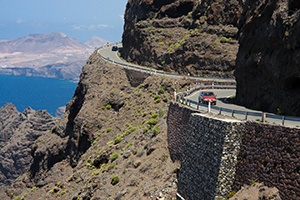 The Pet Shop Boys may never have visited Gran Canaria (to the best of our knowledge), but the lyrics of Go West do a good job of describing Gran Canaria's GC 200 west coast road.
The Pet Shop Boys may never have visited Gran Canaria (to the best of our knowledge), but the lyrics of Go West do a good job of describing Gran Canaria's GC 200 west coast road.
(Go West) Life is peaceful there
(Go West) In the open air
(Go West) Baby you and me
(Go West) This is our destiny
(Go West) Sun in wintertime
(Go West) We will do just fine
(Go West) Where the skies are blue
(Go West, this is what we're gonna do
The GC 200 is one of Europe's great drives and if you need an added incentive to do it on your first visit, then bear in mind that it won't be there forever. A new inland route is in the works and one day, the original cliff-edge route will be closed.
The route starts just inland of Mogán village inland from Puerto de Mogán and winds through rugged volcanic landscapes and past the technicolour rocks, the tip of a volcanic crater buried by a later eruption. Then it drops through a pass so steep that it is known locally as a degollada ( translated as a throat slit) into the remote west coast town of La Aldea. This town was only connected to the rest of Gran Canaria by road in the 1960s and still has its own character as well as one of Gran Canaria's craziest annual fiestas.
From La Aldea, the GC 200 winds back up to the hair-raising Anden Verde cliffs. Here the road is protected from rockfalls by huge nets and the cliff drops over a kilometre to the sea. Stop at the El Balcon mirador for epic views of the Dragon's Tail rocks in west Gran Canaria (stop at the snack van).
The road continues at breathtaking heights until you reach Puerto de las Nieves and Agaete in the west corner of the island. Stop by the sea for lunch and a swim, or head inland into Europe's most tropical valley where coffee bushes grow in the shade of the mango trees.
Hill towns
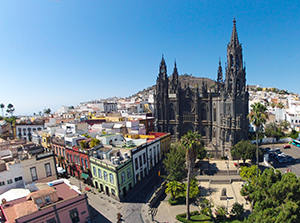 You have to visit one of Gran Canaria's hill towns, but choosing one isn't easy (here's ten to consider).
You have to visit one of Gran Canaria's hill towns, but choosing one isn't easy (here's ten to consider).
Agüimes in the east has a huge church, whitewashed houses and cobbled streets and is the gateway to the spectacular Guayadeque valley and its cave houses and restaurants. In the north, the huge Arucas church dominates a town that was once the richest place in the Canary Islands thanks to sugar cane plantations. It still has a rum factory with free tastings, as well as majestic period houses and a pretty urban park. Or go for Teror, the most Canarian of Gran Canaria's towns and home to the island's patron saint. Other options include the old centre of Galdar on the north coast and the cliff edge town of Moya.
Remote beaches
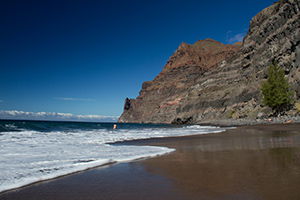 Over four million people visit Gran Canaria every year, but most of its smaller beaches don't get more than a handful of visitors a day. Guayedra in north-west is easy to access but feels completely natural, while Agua Dulce on the east coast is idyllic in winter when the wind is low.
Over four million people visit Gran Canaria every year, but most of its smaller beaches don't get more than a handful of visitors a day. Guayedra in north-west is easy to access but feels completely natural, while Agua Dulce on the east coast is idyllic in winter when the wind is low.
In the south, the white-sand beach within Pasito Blanco marina is a faff to get to (the marina is private but you can walk in) but is often empty mid-week while Montaña de Arena sits at the base of a vast sand dune. Next door Playa de las Mujeres is even quieter and both are nudist friendly.
In the west, GüiGüi beach is legendary as Gran Canaria's original hippy hangout. It's a two-hour walk through steep, pristine natural landscapes to get to the sand, and a long two-hour hike back up the hill, but GüiGüi deserves a visit. True adventurers can push the remote beach dial one stop higher by tracking down
True adventurers can push the remote beach dial one stop higher by tracking down black-sand Faneroque beach in the far west while slackers can get a mini GüiGüi experience by walking from the Gc 500 road down to Tiritaña beach between Puerto Rico and Puerto de Mogán resorts.
To choose a remote beach that suits you, see our complete guide to Gran Canaria's beaches.
Party like a local
 Gran Canaria's resorts buzz 24/7/365, but there's another party scene in Gran Canaria that only gets going at the weekends. Every town on the island has an annual fiesta, known as a romeria, with local music, food and dancing and visitors are welcome to come along and join in. While some places keep their romerias traditional, others do things on an epic scale. In west coast La Aldea, 50,000 people run into a lagoon while, in Agaete, 70,000 people get together to celebrate a festival that dates back thousands of years. Not content with on annual blowout, Agaete and Puerto de las Nieves also host Gran Canaria's biggest music festival.
Gran Canaria's resorts buzz 24/7/365, but there's another party scene in Gran Canaria that only gets going at the weekends. Every town on the island has an annual fiesta, known as a romeria, with local music, food and dancing and visitors are welcome to come along and join in. While some places keep their romerias traditional, others do things on an epic scale. In west coast La Aldea, 50,000 people run into a lagoon while, in Agaete, 70,000 people get together to celebrate a festival that dates back thousands of years. Not content with on annual blowout, Agaete and Puerto de las Nieves also host Gran Canaria's biggest music festival.
From mud fights to burning men, there's always a local party on somewhere in Gran Canaria; Here's a list of the ten most spectacular annual parties.
By car boat or bus: Just do it
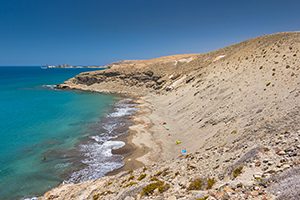 The key to appreciating Gran Canaria on your first visit is to do something, anything, that takes you beyond the gates of the resorts: Rent a car (we seriously recommend it), get on the local buses, or take a boat trip to see the dolphins and the south coast. You haven't really been to Gran Canaria unless you've sat on an empty beach, met a goat, eaten something you don't recognise, chatted to a local on their porch, and smelt the pine forests.
The key to appreciating Gran Canaria on your first visit is to do something, anything, that takes you beyond the gates of the resorts: Rent a car (we seriously recommend it), get on the local buses, or take a boat trip to see the dolphins and the south coast. You haven't really been to Gran Canaria unless you've sat on an empty beach, met a goat, eaten something you don't recognise, chatted to a local on their porch, and smelt the pine forests.
Car rental in Gran Canaria is cheap, safe and reliable provided that you know which companies to avoid. We've made that easy with our Gran Canaria car hire guide. For bus information, see this useful guide and for resort info, we have detailed resort guides. Experiencing the Gran Canaria that we know and love is far easier that you think and far more rewarding that one more mojito by the pool (although we recommend that too).


